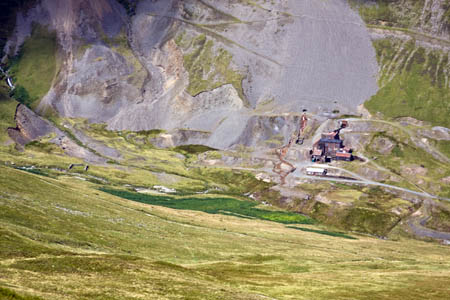
Force Gill Mine, at the head of Coledale
Footpath repair work on a Cumbrian fell is helping improve water quality in a lake 7km (4½ miles) away.
The track, above the Lake District’s last operating mineral mine, had become badly worn and ‘pigeonholed’ leading to ascending holes where countless boots had exposed soil to the elements.
The work, near Force Crag Mine in Coledale, west of Keswick, was carried out as part of the Fix the Fells scheme, using volunteers and National Trust staff. The repairs will stop the flow of sediment that was threatening the fish breeding areas of Bassenthwaite Lake.
Without repair, the pigeonholed track allows a gully to form, washing loose earth into becks and rivers and into the lake, damaging wildlife and lowering water quality.
Force Crag Mine, which finally closed in 1991, was thought to have been the site of mining since the Elizabethan period, and was a source of lead, baryte and zinc. Now owned by the National Trust, its buildings and machinery have been restored and it is a scheduled ancient monument. It lies on the southern flank of Grisedale Pike.
The trust and Fix the Fells worked on the project with the Bassenthwaite Lake Restoration Programme. John Malley, of BLRP, said the repairs not only benefited access to the fells and water quality, but also to the health of rivers and lakes.
He said: “While repairs were relatively simple, their impact is significant. We need to catch these erosion spots before they develop into major scars. By filling holes with soil and small rocks, and adding a protective willow and net cloche, the track will soon be as good as new.
“Although you won’t see many of these repair methods in the Lake District, it is a very successful one, effectively treating and covering over the damage.”
The project is working towards returning water quality in Bassenthwaite to its clean, clear pre-war state, although recent surveys suggest the Ice Age fish the vendace may already be extinct in the lake, leaving Derwent Water the only UK site where they survive.